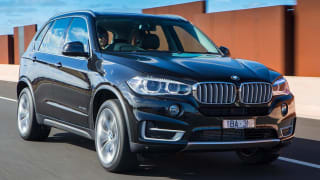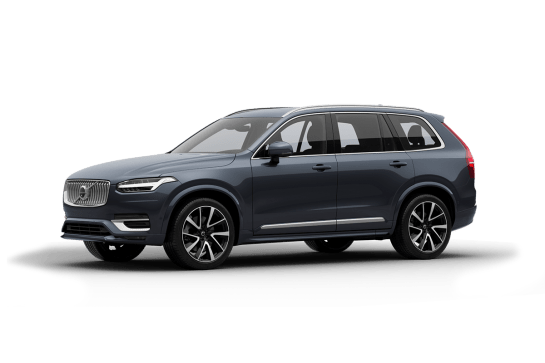
BMW X5 2015 review
In the beginning there were prestige SUVs. They were big, lumbering behemoths with a token...
Browse over 9,000 car reviews
A tiny Swedish flag pokes out of the front seat stitching on every new Volvo XC90 -- even though the brand is owned by Chinese car giant Geely.
It's one of the ways Volvo is reclaiming its identity, even though it has been owned by foreign firms for the better part of two decades.
Volvo was bought by US car maker Ford in 1999 and, faced with mounting losses, was sold to the Chinese in the wake of the Global Financial Crisis in 2010.

As the first Volvo designed, engineered and manufactured under Chinese ownership, the industry's eyes are on this crucial new model.
This is the first all-new XC90 in 12 years
Mums on the run just want to know if it's any better than the last one, and how it compares to the current crop of luxury SUVs.
It's fair to say they've been waiting long enough. This is the first all-new XC90 in 12 years (an age in the car industry, most models are replaced in half that time).
When the original XC90 arrived in 2002 it was one of the pioneers in the luxury SUV segment and became the best selling Volvo in many markets around the world, including Australia.
Back then, Volvo had almost no competition. BMW and Mercedes-Benz had only recently joined the luxury SUV market, Audi was still getting around to it, and Range Rover had just one model (today it makes three, with more coming).
Nowadays the well-heeled are spoiled for choice when it comes to seven-seat SUVs with a shiny badge and plenty of pose factor.
To that end, Volvo has amped up the visual appeal, giving the new XC90 much bolder lines and menacing eyes in the form of daytime running lamps that have been likened to Thor's hammer.
For the record, the designers created the horizontal T-shaped lamps inside the headlights because they looked good (and differed from other brands).
Then someone apparently walked into the design studio one day and said "they look like Thor's hammer". And so another tale for Scandinavian mythology was born.
As you might expect, Volvo has loaded the new XC90 with the latest safety equipment, including a couple of world firsts.
In addition to automatic emergency braking (which Volvo pioneered in on the XC60 in 2008) the Volvo XC90 will intervene if you try to turn in front of oncoming traffic.
If all the car's preventative measures don't work and you drive off the road, the car will prepare the safety systems and tighten the seatbelts immediately before the crash because, thanks to some new whiz bang sensors, it knows you've driven off piste at speed.
On a preview drive in Europe this week our mission was to not test this important new element of the Volvo XC90's suite of safety technology.
First impressions from behind the wheel? The new Volvo XC90 smells like a Range Rover. Which is fitting, because the new Volvo XC90 has a much more upmarket appearance than before -- and a price tag to match.
The range will start at $89,950 plus on-road costs -- a massive $20,000 jump on the current model -- when it goes on sale in Australia in August, and will top out at $122,950 when the flagship plug-in hybrid arrives at the end of the year.
But it's clear Volvo hasn't put all of the price premium in its pocket. The detailing inside the new Volvo XC90 is exquisite, from the quality and feel of the materials (if it looks like metal it's metal, if it looks like leather it's leather and if it looks like timber it's also the real deal), to the tiny diamond-shaped impressions on the toggle switches and the crystal-like appearance of the gear lever (ok, that's not really crystal) that delight the senses.
The seating layout is clearly designed with families in mind. The second row slides forward with the lifting of one latch to get access to -- or create extra leg-room for -- the third-row seats. And there's room in the back for two adults (185cm), with space for luggage behind them.
There are three engine choices, all of which may take some buyers a bit of time to come to terms with. Volvo is using four-cylinder engines in various configurations to move this two-tonne-plus mass.
The 2.0-litre twin turbo diesel is expected to be the most popular choice (representing more than half of XC90 sales locally) and it was the first one we tested.
Power was surprisingly good. In all honesty, had I not known such a small engine was under the bonnet, I would never have guessed. It was a tad noisy (even by diesel standards) but was eager to move, even with a light press of the accelerator pedal.
The 2.0-litre petrol engine, which is supercharged and turbocharged, was another surprise packet. Power delivery was smoother and quieter and, as with the diesel, worked seamlessly with the eight-speed automatic.
The plug-in hybrid has V8-like performance despite using the same petrol engine, only this time mated to an electric motor for extra oomph.
Downsides? Volvo has created one of the safest SUVs on sale, but conspicuous by its absence are seat-mounted side airbags for second-row passengers. The XC90 comes with seven airbags (a driver's knee airbag, two frontal airbags, one in the side of each front seat and two curtain airbags that go all the way to the third row) but the Toyota LandCruiser comes with 10 airbags (adding side airbags for second-row seats and a knee airbag for the front passenger which the Volvo lacks).
The tablet-sized screen uses the shadow of your finger (rather than touch) to activate various functions and it's less responsive and less accurate than using a smartphone or iPad.
There is only one USB charge point (the kids will be fighting parents over it) when even some hatchbacks and sedans have up to three these days (in Europe there is a household power socket to charge a computer or similar device, it's unclear if ours will come with an Australian power socket).
And the steering felt vague in certain situations (freeway driving) and unwieldy in others (suburban driving) and the suspension was too floaty, even by luxury-car comfort standards. That said, the cars tested were riding on air suspension, which will be optional on models sold in Australia.
One last thing: the turning circle is better than before, but it's still like trying to make a U-turn in the QEII. If you order a new Volvo XC90 with skinny tyres it has a turning circle of 11.8 metres -- the same as a Toyota LandCruiser. Order one with wider tyres and you'll need 12.1 metres of road to turn back the other way. Yikes.
The new Volvo XC90 looks the business and brings new levels of fuel economy and safety technology to luxury SUVs. It just needs to make it feel more secure in corners, steer better, and feel nicer over bumps.
| Vehicle | Specs | Price* | |
|---|---|---|---|
| T6 2.0 Momentum | 2.0L, PULP, 8 SP AUTO | $43,780 – 50,930 | 2015 Volvo XC90 2015 T6 2.0 Momentum Pricing and Specs |
| D5 2.0 Momentum | 2.0L, Diesel, 8 SP AUTO | $44,550 – 51,810 | 2015 Volvo XC90 2015 D5 2.0 Momentum Pricing and Specs |
| D5 Executive | 2.4L, Diesel, 6 SP AUTO | $27,830 – 33,550 | 2015 Volvo XC90 2015 D5 Executive Pricing and Specs |
| 3.2 Executive | 3.2L, PULP, 6 SP AUTO | $27,830 – 33,550 | 2015 Volvo XC90 2015 3.2 Executive Pricing and Specs |
$22,330
Lowest price, based on third party pricing data